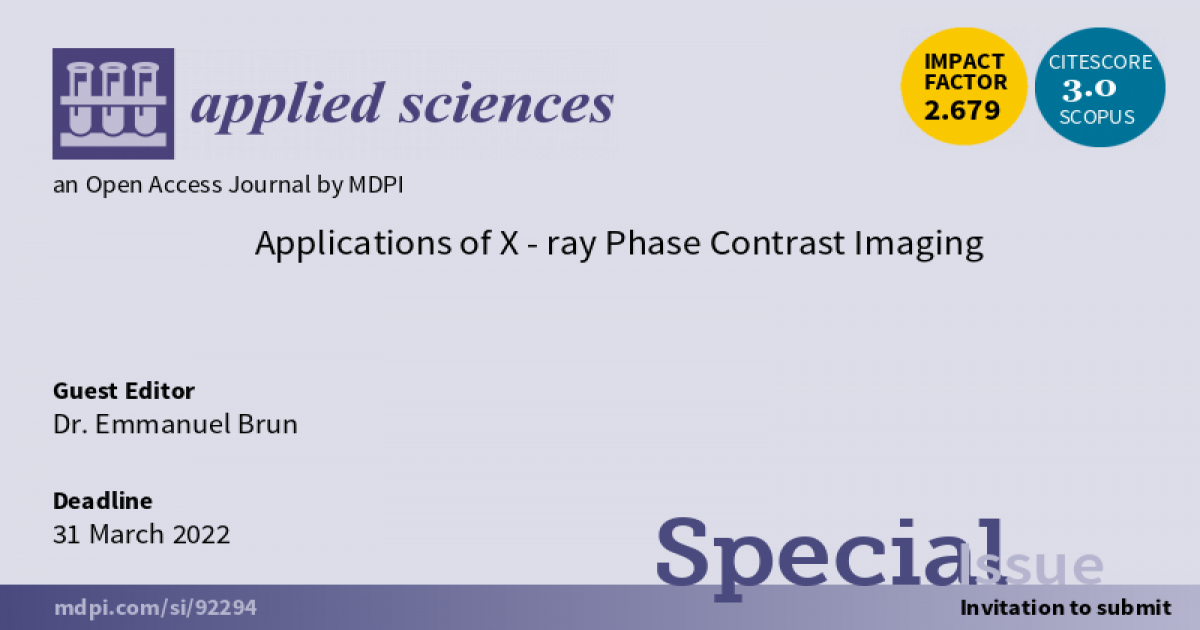Applications of X-ray Phase Contrast Imaging
A special issue of Applied Sciences (ISSN 2076-3417). This special issue belongs to the section "Optics and Lasers".
Deadline for manuscript submissions: closed (31 March 2022) | Viewed by 3550

Special Issue Editor
2. Department of Synchrotron Radiation and Medical Research, Universite Grenoble Alpes, 38400 Saint Martin d'Heres, France
Interests: X-ray phase contrast imaging; computed tomography, osteo-articular imaging; virtual histology; image segmentation
Special Issue Information
Dear Colleagues,
X-ray Phase Contrast Imaging appeared few decades ago as an alternative to standard absorption-based Imaging. With X-rays, the refractive index of materials can be a thousand times greater than its counterpart absorption factor for light elements. This translates into a much greater contrast for soft tissues with X-ray imaging methods based on the sensing of the phase. This property becomes highly interesting when one wants to image with high-resolution biological tissue or light material that are generally admitted to be transparent to X-rays. With the emergence of partially coherent X-ray sources twenty years ago, expectations regarding PCI turned into a reality with the development at synchrotrons of several advanced PCI methods, some of them even later being adapted to laboratory sources.
In this Special Issue, we invite submissions exploring cutting-edge research and recent advances in the fields of X-ray Phase Contrast Imaging. Both theoretical and experimental studies are welcome, as well as comprehensive review and survey papers.
Dr. Emmanuel Brun
Guest Editor
Manuscript Submission Information
Manuscripts should be submitted online at www.mdpi.com by registering and logging in to this website. Once you are registered, click here to go to the submission form. Manuscripts can be submitted until the deadline. All submissions that pass pre-check are peer-reviewed. Accepted papers will be published continuously in the journal (as soon as accepted) and will be listed together on the special issue website. Research articles, review articles as well as short communications are invited. For planned papers, a title and short abstract (about 100 words) can be sent to the Editorial Office for announcement on this website.
Submitted manuscripts should not have been published previously, nor be under consideration for publication elsewhere (except conference proceedings papers). All manuscripts are thoroughly refereed through a single-blind peer-review process. A guide for authors and other relevant information for submission of manuscripts is available on the Instructions for Authors page. Applied Sciences is an international peer-reviewed open access semimonthly journal published by MDPI.
Please visit the Instructions for Authors page before submitting a manuscript. The Article Processing Charge (APC) for publication in this open access journal is 2400 CHF (Swiss Francs). Submitted papers should be well formatted and use good English. Authors may use MDPI's English editing service prior to publication or during author revisions.
Keywords
- X-ray phase contrast imaging
- micro and nanocomputed tomography
- virtual histology
- radiation dose reduction
- grating interferometry
- analyzer-based imaging
- edge illumination
- speckle-based imaging
Benefits of Publishing in a Special Issue
- Ease of navigation: Grouping papers by topic helps scholars navigate broad scope journals more efficiently.
- Greater discoverability: Special Issues support the reach and impact of scientific research. Articles in Special Issues are more discoverable and cited more frequently.
- Expansion of research network: Special Issues facilitate connections among authors, fostering scientific collaborations.
- External promotion: Articles in Special Issues are often promoted through the journal's social media, increasing their visibility.
- e-Book format: Special Issues with more than 10 articles can be published as dedicated e-books, ensuring wide and rapid dissemination.
Further information on MDPI's Special Issue policies can be found here.





